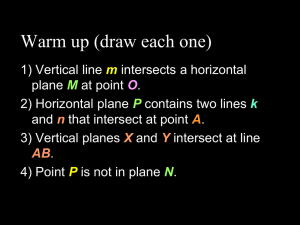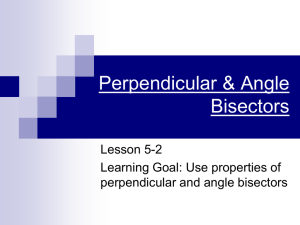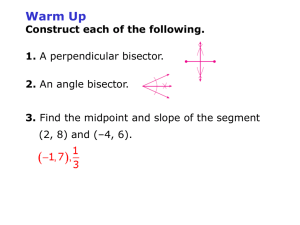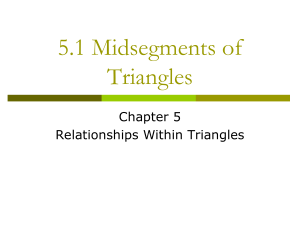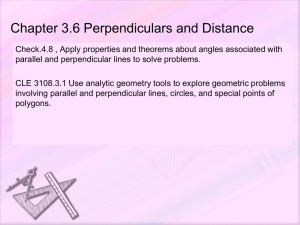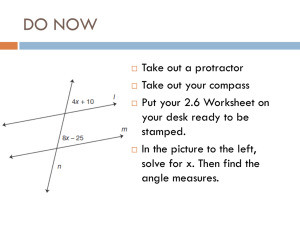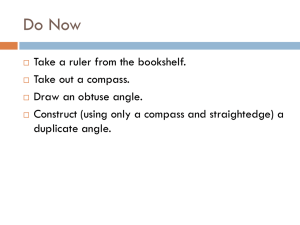File
advertisement
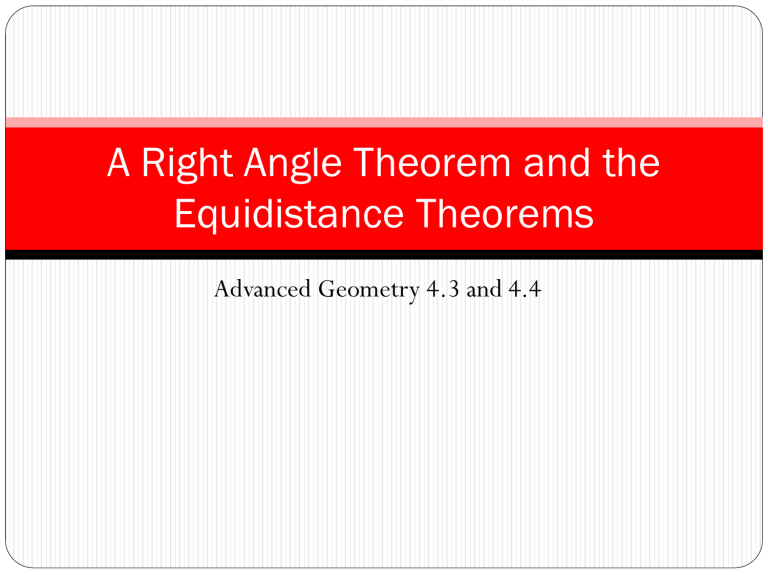
A Right Angle Theorem and the Equidistance Theorems Advanced Geometry 4.3 and 4.4 You did it! Add to your Index Cards! Right Angle Theorem: If two angles are both supplementary and congruent, then they are right angles. Example Given: Circle P S is the midpoint of Prove: P Q S R Given: Circle P S is the midpoint of Example Prove: Statements Reasons 1. Circle P 1. Given 2. S is the midpoint of P Q S R QR 2. Given 3. QS SR 3. Def of midpt 4. PS PS 5. Draw PQ and PR 4. Reflexive 6. PQ PR 6. All radii of a circle are 7. PQS PRS 7. SSS 8. PSQ PSR 8. CPCTC 9. PSQ and PSR are supp 9. Def of supp 5. Two points det a seg 10. PSQ and PSR are rt ' s 10. If two angles are supp and congruent, then they are right angles. 11. PS QR 11. Def of perpendicular A.) (def) Distance (between two objects) is the length of the shortest path joining them. B.) (postulate) A line segment is the shortest path between two points. AB segment itself A B AB length of segment Definition of Equidistance: If 2 points P and Q are the same distance from a third point EQUIDISTANT X, then X is said to be _____________ P from P and Q. X Q Definition of a Perpendicular Bisector: • A perpendicular bisector of a segment is the line that both BISECTS and is _____________ PERPENDICULAR _________ to the segment. L is bisector of AB A B X L Theorem: If 2 points are equidistant from the endpoints of a segment, then they determine the P perpendicular bisector of that segment. E P and Q are two points that are equidistant from E and D (the endpoints of segment ED), so they determine the perpendicular bisector of the segment (ED). Q NEEDED: 2 points equidistant or 2 pairs congruent segments D Theorem: If a point is on the perpendicular bisector of a segment, then it is equidistant from the endpoints of the P segment. If N is on PQ, the perpendicular bisector of ED, then N is equidistant from E and D. (EN = ND) E NEEDED: Perpendicular bisector of the segment N Q D TRUE/FALSE PRACTICE Ready?? C A AD bi sec tor of BC E D B 1. E is the midpoint of BC. TRUE C A AD bi sec tor of BC E D B 2. <AEC is a right angle TRUE C A AD bi sec tor of BC E D B 3. E is the midpoint of AD FALSE C A AD bi sec tor of BC E D B 4. AC AB TRUE C A AD bi sec tor of BC E D B 5. CE BE TRUE C A AD bi sec tor of BC E D B 6. CA CD FALSE C A AD bi sec tor of BC E D B 7. AE ED FALSE C A AD bi sec tor of BC E D B 8. CB bi sec ts AD FALSE M Example #1 N Given: MN MP NQ PQ Prove: NO PO Statements 1. MN MP 2. NQ PQ Reasons_____________________ 1. Given 2. Given. 3. MQ is perpendicular to NP 3. If two points are equidistant from the 4. NO = PO Q O endpoints of a segment, then they determine the perpendicular bisector of that segment. 4. If a point is on the perpendicular bisector of a segment, then it is equidistant from the endpoints of that segment. P Example Problem 2 M Given: AM≅MH AP≅PH Prove: ΔAPT≅ΔHPT P A T H Statements Reasons 1. AM≅MH 1. Given 2. AP ≅ PH 2. Given 3. MT is the perpendicular bisector of AH 3.If two points are equidistant from the endpoints of a segment, then they determine the perpendicular bisector of that segment. 4. < PTH, <PTA are right angles 4. Perpendicular lines form right angles (Def of perpendicular) 5. ΔPTH, ΔPTA are right triangles 5. Def of right triangle 6. PT≅PT 6. Reflexive 7. ΔAPT≅ΔHPT 7. HL (2,5,6) Example Problem 3 K Given: KL is the perpendicular bisector of YE Prove: ΔKBY≅ΔKBE B Y L E Statements 1. KL is the perpendicular bisector Reasons 1. Given of YE 2. YB ≅ BE 2. If a point is on the perpendicular bisector of a segment, then it is equidistant from the endpoints of that segment 3. KY≅KE 3. Same as 2 4. KB≅KB 4. Reflexive 5. ΔKBY≅ΔKBE 5. SSS (2,3,4)

